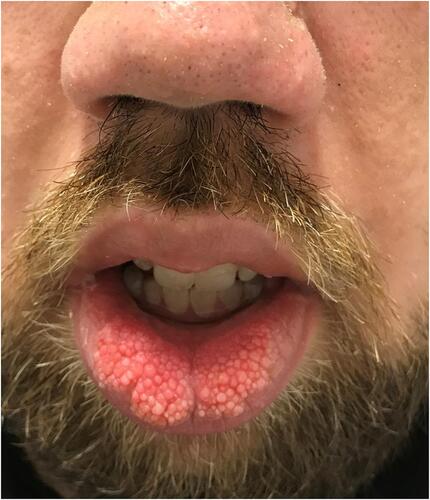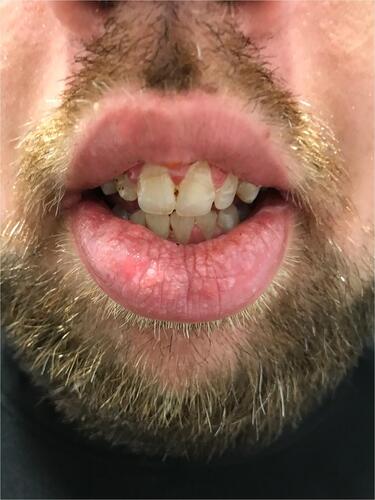Abstract
Background
Cowden’s syndrome is a genetic disorder characterized by multiple oral hamartomas and an increased risk of internal malignancy. These mucocutaneous lesions can be physically disfiguring and psychologically distressing. As a result, patients frequently seek treatment for their destruction. Removal of oral hamartomas is often a challenge due to their sensitive location and high risk of recurrence.
Objective
To review the clinical use, effectiveness, and safety of a fractional ablative laser to treat multiple oral hamartomas in a patient with Cowden’s syndrome.
Materials and Methods
A thorough literature review pertaining to treatment of oral hamartomas and a discussion of an illustrative case showcasing successful lesional destruction with a fractional ablative carbon dioxide (CO2) laser in a 33-year-old man with Cowden’s syndrome.
Results
Multiple oral hamartomas were effectively removed with fractional CO2 laser vaporization. No infection, scarring, dermatitis, nor lesional recurrence were observed 6 months post-treatment.
Conclusion
Fractional CO2 laser vaporization can be used effectively to treat multiple oral hamartomas associated with Cowden’s syndrome.
Introduction
Cowden’s syndrome (CS) is a rare genodermatosis of autosomal dominant inheritance and variable expression.Citation1–Citation3 Its prevalence is unknown but is estimated at 1 in 200,000.Citation4
Clinical manifestations of the disease include mucocutaneous lesions, thyroid abnormalities, fibrocystic breast disease, uterine leiomyomas, gastrointestinal hamartomas, macrocephaly, and developmental delay. Malignancies of the breast, thyroid, kidney, and endometrium appear later in life.
The syndrome was named after Rachel Cowden in 1963 who presented with multiple oral papules and cystic breast cancer.Citation3 The primary indicator of CS is the presence of multiple asymptomatic cutaneous hamartomas, which typically develop prior to internal disease. The International Cowden Consortium dictates a diagnosis of CS when the pathognomonic skin lesions (trichilemmomas, papillomas, fibromas, acral keratoses) and a combination of major (malignancies) and minor (gastrointestinal polyps) criteria are in evidence. The disease is caused by a mutation in the PTEN tumor suppressor gene located on chromosome 10 which encodes for a protein with phosphatase activity.Citation4 Individuals with a germline PTEN mutation are at increased risk for internal malignancy, especially in the breast, thyroid, and endometrium.Citation3,Citation5
Laser technology has been used to successfully treat a wide variety of cutaneous lesions including trichilemmomas, syringomas, xanthelasma, and angiofibromas.Citation6,Citation7 Since the last systematic review of CO2 laser vaporization of multiple cutaneous hamartomas was published by Wheeland et al in 1989Citation8 and the technology has undergone substantial evolution,Citation9 the purpose of our publication is to provide an updated evaluation of the safety and efficacy of fractional ablative laser skin resurfacing for the treatment of multiple oral hamartomas in a patient with CS.
Literature Review
Three databases (PubMed, MEDLINE, Wiley Online Library) were mined from inception until September 1, 2021, utilizing search strings based on fractional ablative laser resurfacing and mucocutaneous lesions in Cowden’s syndrome. Additional studies were identified through Google Scholar web search and bibliographies from the aforementioned database search results.
Case Report
A 33-year-old man with Cowden’s syndrome and a 10-year history of numerous (>50) small (1-to-5 mm diameter), firm, flesh-colored papules on his lower lip mucosa presented for evaluation and treatment considerations (). The papules were previously biopsied with histopathologic confirmation of benign hamartomas. Medical history included a diagnosis of testicular cancer, which had been eradicated by orchidectomy 12 years prior to presentation. Previous treatment of the hamartomas with topical sirolimus provided no significant cosmetic improvement and the patient refused further topical treatment due to its associated inconvenience and skin irritation. Because the papillomatous papules on the lower lip and adjacent mucosa continued to increase in size and number with worsening friability and easy bleeding, the patient was inclined to seek in-office treatment.
Figure 1 Numerous small, firm, flesh-colored papules (biopsy-proven benign hamartomas) on the lower lip mucosa prior to treatment.

Figure 2 Marked lesional reduction and improved lip contour with absence of tissue friability was evident at 6 weeks post-treatment and maintained at 6 month follow-up.

After written informed consent was obtained, treatment sites were anesthetized with topical and intralesional lidocaine. The lower lip papules were vaporized using multiple consecutive passes of a fractionated CO2 laser (Fraxel: repair; Solta Medical, Pleasanton, CA) with a 2-mm spot size at 225 mJ energy and 10 W of power. Intraoperative side effects consisted of lesional friability, difficulty with hemostasis, edema, and erythema. Dilute acetic acid and ice water compresses were applied to the ablated skin immediately post-treatment for 15 minutes and repeated 4 times daily. The wounds were kept well lubricated with a compounded mix of mupirocin and Aquaphor ointments which was applied after each application of the dilute acetic acid compresses until re-epithelization was complete (7 days). Topical sirolimus was not provided after treatment due to its previous untoward side effects and the patient’s vehement refusal to resume its use. Marked lesional reduction and improved lip contour with the absence of tissue friability was evident and maintained at 6 weeks post-treatment (). No lesional recurrence was reported 6 months hence.
Discussion
Cowden’s syndrome is a rare condition and its associated multiple hamartomas pose a therapeutic challenge.Citation8 While the increased risk for internal malignancy in CS is the primary concern, the psychological, social, and physical implications associated with multiple facial papules can also be debilitating.Citation8 Prior treatments including 5-fluorouracil injections, oral retinoids, sirolimus, surgical excision, laser ablation, cryosurgery, dermabrasion, and electrodesiccation and curettage have limited clinical utility.Citation1,Citation2 Advances in laser technology over the past 3 decades have led clinicians to examine their effectiveness in treating this aesthetically challenging condition.
Successful removal of hamartomas in patients with CS was initially achieved utilizing ablative carbon dioxide (CO2) or erbium: yttrium-aluminum-garnet (Er:YAG) laser systems.Citation10 Their use dwindled with the subsequent development of fractional lasers and other specialized laser techniques that reduced postoperative recovery time and risk of complications.Citation9
The advent of fractional lasers launched a new approach to treatment in patients with CS suffering from multiple hamartomas. In contrast to traditional ablative lasers wherein the entire epidermis and variable portions of the dermis are vaporized, fractional photothermolysis creates microscopic wounds in the treated skin thereby inducing coagulation without confluent epidermal damage.Citation11 As a result, this method of laser delivery stimulates collagen remodeling and re-epithelization while reducing post-treatment recovery time and risk of untoward side effects and complications such as scarring and dyspigmentation typically associated with ablative (non-fractional) laser skin resurfacing.Citation9,Citation11,Citation12
In addition, a specialized technique utilizing a “pinhole method” of CO2 laser vaporization has proven effective for a broad range of dermal lesions, including multiple trichilemmomas in a CS patient.Citation13 Similar to fractional laser treatment, this laser technique induces collagen regeneration by creating microscopic holes which penetrate from the epidermis to the deep dermis and is associated with fewer side effects and quicker healing.
Laser ablation is not always sufficient in removing unwanted papules when performed alone. Therefore, combination laser treatment with topical or oral sirolimus has been advocated.Citation14 Sirolimus is an mTOR inhibitor and analog of rapamycin that is commonly used as an immunosuppressive agent after organ transplantation.Citation15 The PTEN mutation linked to Cowden’s syndrome results in inhibition of the PDK1/Akt/mTOR pathway.Citation5 Administration of sirolimus plays an important role in regulating the cell cycle thereby preventing abnormal cell proliferation and reducing the recurrence of multiple hamartomas. Serious side effects and complications may result from taking sirolimus and patients must be monitored for unusual symptoms.
Conclusion
There are now several different treatments that can be used singly or in combination to reduce multiple hamartomas. The development of fractional CO2 laser technology has enabled practitioners to apply yet another tool to provide longstanding clinical improvement with reduced untoward side effects.Citation9 Critical to the success of this technology is the expertise of the practitioner as well as appropriate postoperative management and wound care to ensure optimal healing and cosmetic outcomes.Citation16 Despite the excellent safety record and clinical effectiveness of these specialized lasers, their improper intraoperative use and/or inadequate post-treatment patient care could potentially result in incomplete lesional eradication and/or adverse side effects.Citation16
In the case described herein, fractional ablative CO2 laser vaporization was effectively used as the sole treatment to reduce multiple oral hamartomas associated with Cowden’s syndrome with minimal recovery and post-treatment side effects. Further investigation regarding CS, hamartoma morphology, and advances in laser technology may elucidate critical information to optimize the treatment approach for this clinically and aesthetically complex condition.
Ethics and Consent Statements
Institutional approval was not required to publish these case details. Written informed consent was obtained by the patient for publication of the case details.
Disclosure
The authors report no conflicts of interest in this work.
References
- Aslam A, Coulson IH. Cowden syndrome (multiple hamartoma syndrome). Clin Exp Dermatol. 2013;38(8):957–959. doi:10.1111/ced.12140
- Chippagiri P, Banavar Ravi S, Patwa N. Multiple hamartoma syndrome with characteristic oral and cutaneous manifestations. Case Rep Dent. 2013;315:109–114.
- Mester J, Eng C. Cowden syndrome: recognizing and managing a not-so-rare hereditary cancer syndrome: Cowden Syndrome. J Surg Oncol. 2015;111(1):125–130. doi:10.1002/jso.23735
- Lopes S, Vide J, Moreira E, Azevedo F. Cowden syndrome: clinical case and a brief review. Dermatol Online J. 2017;23(8):52–55.
- Pilarski R, Burt R, Kohlman W, et al. Cowden syndrome and the PTEN hamartoma tumor syndrome: systematic review and revised diagnostic criteria. J Natl Cancer Inst. 2013;105(21):1607–1616. doi:10.1093/jnci/djt277
- Klein A, Bäumler W, Landthaler M, Babilas P. Laser thermal therapy of benign skin tumors: review and update. Int J Hyperthermia. 2011;27:762–770. doi:10.3109/02656736.2011.599049
- Pecaro BC, Garehime WJ. The CO2 laser in oral and maxillofacial surgery. J Oral Maxillofac Surg. 1983;41(11):725–728. doi:10.1016/0278-2391(83)90189-1
- Wheeland RG, McGillis ST. Cowden’s disease—treatment of cutaneous lesions using carbon dioxide laser vaporization: a comparison of conventional and superpulsed techniques. J Dermatol Surg Oncol. 1989;15(10):1055–1059. doi:10.1111/j.1524-4725.1989.tb03122.x
- Aslam A, Alster TS. Evolution of laser skin resurfacing: from scanning to fractional technology. Dermatol Surg. 2014;40:1163–1172. doi:10.1097/01.DSS.0000452648.22012.a0
- Alster TS. Cutaneous resurfacing with CO2 and erbium: YAG lasers: preoperative, intraoperative, and postoperative considerations. Plast Reconstr Surg. 1999;103(2):619–632. doi:10.1097/00006534-199902000-00040
- Brightman LA, Brauer JA, Anolik R, et al. Ablative and fractional ablative lasers. Dermatol Clin. 2009;27(4):479–489. doi:10.1016/j.det.2009.08.009
- Metelitsa AI, Alster TS. Fractionated laser skin resurfacing treatment complications: a review. Dermatol Surg. 2010;36(3):299–306. doi:10.1111/j.1524-4725.2009.01434.x
- Chang I, Lee Y, Seo Y, Kim C, Lee J, Im M. Treatment of multiple trichilemmomas with the pinhole method using a carbon dioxide laser in a patient with Cowden syndrome: multiple trichilemmomas treated by CO2 laser. Dermatologic Ther. 2015;28(2):71–73. doi:10.1111/dth.12212
- Botsali A, Caliskan E, Eşme P, Dündar Ö. Oral hamartomatous lesion of Cowden’s disease treated with the combination of erbium: YAG laser and topical sirolimus. Dermatol Ther. 2019;32(5). doi:10.1111/dth.13002
- Iacobas I, Burrows PE, Adams DM, et al. Oral rapamycin in the treatment of patients with hamartoma syndromes and PTEN mutation. Pediatr Blood Cancer. 2011;41(2):321–323. doi:10.1002/pbc.23098
- Alster TS, Li MK. Dermatologic laser side effects and complications: prevention and management. Am J Clin Dermatol. 2020;21:711–723. doi:10.1007/s40257-020-00530-2
